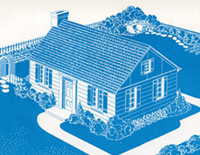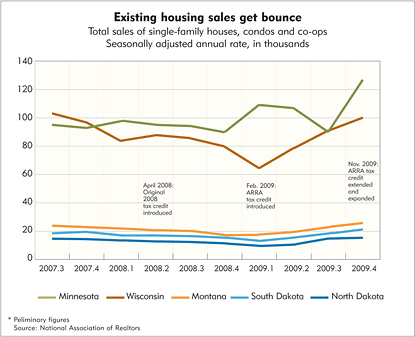
In the midst of the country’s worst housing slump in decades, almost everyone has heard of the tax credit for first-time home buyers.
Indeed, many have used it. How many? Ironically, nobody knows.
The $8,000 credit has received a lot of attention from home buyers and sellers, real estate agents, building contractors and politicians trying to breathe life into a moribund housing sector.
While it’s clear the tax credit has been widely used, the effectiveness of the credit is less clear, for a variety of reasons. Anecdotes abound regarding the popularity of the program and its supposed importance to the housing industry. But for all the good it is reportedly doing, no one has a firm grasp on how often it has been used or how many additional home sales it has induced—rather than merely subsidizing sales that likely would have occurred anyway.
Buying a tax credit
First, a brief history. The United States is currently on its third iteration of a home-purchase tax credit. The original version was created in April 2008 as part of the Bush administration’s Housing and Economic Recovery Act, offering a $7,500 tax credit that had to be repaid over 15 years ($500 per year). In essence, the credit was an interest-free loan.
The economic stimulus bill (the American Recovery and Reinvestment Act) of early 2009 increased the credit to $8,000 and upgraded it to a full tax credit that did not require repayment. It was slated for sunset in late fall of 2009, but Congress, under heavy political and popular pressure, extended the tax credit through the end of April 2010 to buyers with a purchase contract in hand (deal closure is required by the end of June). An additional provision allows homeowners who have occupied their first or second home for at least five years to grab a $6,500 tax credit if they buy a more expensive house. Buyers need only keep the home as their primary residence for at least three years.
The tax credit is widely perceived to have helped stabilize the badly wounded housing market. Sales of existing homes rose throughout 2009 in district states (see chart). Though not all of these sales can be attributed to the tax credit, some evidence and anecdotes suggest that the tax credit persuaded more people to purchase a home than might otherwise have done so. That shouldn’t be surprising—basic economic theory states that when the price of something is lowered, people will buy more of it. It also distorts supply and demand for housing and imposes public costs projected to reach $20 billion or more. As economists are wont to say, there’s no free lunch.
Despite the program’s public popularity, it’s not known to what extent home buyers have taken advantage of the tax credit. Sources with several realty associations said they don’t have a mechanism to track its use, and no government agency has been similarly charged. The only hard data available to date come from the Internal Revenue Service. Even these data are not particularly current, and an IRS official in Minnesota said no updates were expected in the near future.
So here’s what is known: By the end of last August, a total of 1.4 million tax filers had claimed a home buyer’s tax credit, at a cost of almost $10 billion, according to the IRS. Home buyers in the district claimed almost 64,000 tax credits (about 4.5 percent of the national total) to the tune of about $440 million.
Those figures are in line with the district’s share of nationwide population (about 4.4 percent). But the district’s share of tax credits could be considered high in light of the fact that its homeownership rate—almost 71 percent for 2008—was considerably higher than the nation’s (66 percent), meaning that the pool of first-time home buyers was smaller to begin with. This was particularly the case in Minnesota, where the homeownership rate is among the highest in the country (almost 75 percent). The Gopher State also had the most claims—almost 29,000, good for $200 million in tax rebates.
Hurry, hurry, hurry
The assumption is that use of the tax credit accelerated considerably in the fall as total home sales rebounded crisply from very low levels. In Grand Forks, N.D., sales in September and October of 2009 grew almost 40 percent over the same period a year earlier; in Duluth, Minn., November home sales rose by 84 percent over a year earlier; and in the Twin Cities, October and November home sales grew 44 percent compared to a year earlier (all figures are from realty associations in each region).
While it’s not known exactly how many sales involved the tax credit, sources widely cited the $8,000 appetizer. Aside from testimonials, evidence of the tax credit in action can be seen in other figures. For example, in Minnesota, first-time buyers usually make up about 40 percent of all home purchases, according to Chris Galler, chief operating officer of the Minnesota Association of Realtors. Last year, first-timers accounted for 51 percent of home purchases. Along with investors sweeping up foreclosed homes at a discount, Galler said, “they held up the entire market.”
The tax credit effect can also be seen in the types of homes that have sold. First-time buyers tend to seek smaller, less-expensive homes. In the Twin Cities region, sales of homes under $150,000 were up about 50 percent in 2009, “which, we can easily deduce, is in part due to the credit’s availability,” according to Jeff Allen, research director for the Minneapolis Area Association of Realtors. At the same time, the recession has wrecked the higher end of the market, with sales of homes above $190,000 dropping by 9 percent last year. The same was true in Duluth, where sales of homes below $125,000 were up strongly in 2009, while homes above that price were down, according to the Duluth Area Association of Realtors.
It’s not hard to see why a lot of first-timers in Minnesota chose to buy homes during this period. Along with the tax credit, housing prices have fallen significantly in the face of high foreclosures and a general glut of other homes for sale on the market. Homes sold in the Twin Cities in 2009 received an average price of $105 per square foot, which is 30 percent lower than peak prices in 2006 ($149 per square foot), according to data from the Minneapolis Area Association of Realtors. The S&P/Case-Shiller Index, which tracks housing prices nationwide, shows a 27 percent drop in overall home prices in the Twin Cities over a similar period.
What’s less clear is whether the tax credit helped steer a new, safer course for the housing market—or provided only a temporary respite. When the tax credit expires, will the housing market resume its previous rocky path?
For example, first-time buyers have always been a significant driver of housing sales; if the tax credit moved the percentage of first-time buyers in Minnesota from 40 percent of transactions to a little over 50 percent, as Galler suggested, then the tax credit can safely claim to have induced only a modest fraction of new transactions. A December analysis of the tax credit by the Congressional Research Service pointed out that the combined effect of falling home prices and low mortgage rates on a typical mortgage payment “was around eight times … the homebuyer tax credit.” In other words, the tax credit certainly didn’t discourage sales, but it was already a buyer’s market, and considerable tax dollars subsidized many transactions that would have occurred anyway.
What’s more, the tax increase likely pulled forward additional sales that were planned for some later date, but were fast-tracked to take advantage of the subsidy. Some evidence of that front-loading—and subsequent slackening of sales—exists already. Despite a congressional extension last November of the $8,000 credit and the addition of a $6,500 tax credit for current homeowners, house sales through the end of February have been lackluster compared with last fall.
For example, home sales in Missoula County, Mont., during September and October of last year grew about 10 percent over the same period a year earlier, according to the Missoula Organization of Realtors. But sales in January and February of this year declined by about 5 percent over the same period in 2009.
In Minnesota, according to Galler, “there has not been near the number” of transactions in the first two months of the year, though he added that association members expect a “mini surge” leading into the new deadline at the end of April. In the Twin Cities, according to Allen, after sales went “through the roof” in summer and early fall of 2009, they slowed after the November deadline. “We haven’t seen much increase since then,” Allen said, “though some recent weeks have seen sales start to pick up again, likely in response to the new credit deadline.”
What lies ahead after the tax credit program ends is a scary prospect for many in the housing sector; compounding the absence of a significant tax credit starting in May is the fact that mortgage rates have been at historic lows, and most forecasters see them rising somewhat in the coming months.
Of course, Congress could extend the tax credit yet again—which is a possibility, and something people in the industry have mixed feelings about, according to Galler.
“On an intellectual level, (real estate agents) know the credit has to go away. But it’s hard to give up support when transactions are down,” Galler said. Taking the long view, Galler pointed out that housing markets have swooned before, and eventually recovered, as happened in the 1980s, when mortgage rates were double their current level. “We didn’t have the tax credit in the 1980s, and we got through it.”
Ron Wirtz is a Minneapolis Fed regional outreach director. Ron tracks current business conditions, with a focus on employment and wages, construction, real estate, consumer spending, and tourism. In this role, he networks with businesses in the Bank’s six-state region and gives frequent speeches on economic conditions. Follow him on Twitter @RonWirtz.






